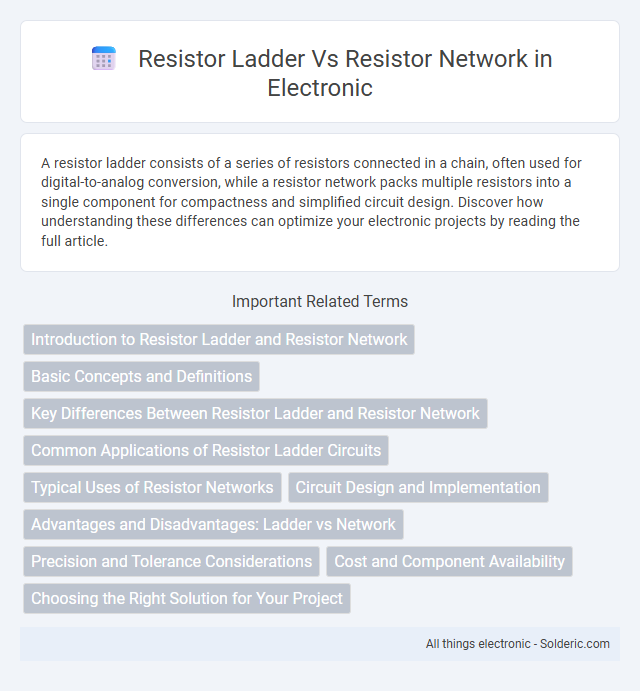A resistor ladder consists of a series of resistors connected in a chain, often used for digital-to-analog conversion, while a resistor network packs multiple resistors into a single component for compactness and simplified circuit design. Discover how understanding these differences can optimize your electronic projects by reading the full article.
Comparison Table
| Feature | Resistor Ladder | Resistor Network |
|---|---|---|
| Definition | Series of resistors connected in a ladder-like configuration | Group of resistors packaged together, may be series, parallel, or mixed |
| Common Types | R-2R Ladder, String Ladder | Matrix, Array, Isolated Networks |
| Applications | Digital-to-Analog Conversion (DAC), Voltage Dividers | Pull-up/pull-down resistors, biasing, signal termination |
| Configuration | Fixed ratio resistors arranged sequentially | Various resistor arrangements in a single package |
| Advantages | Accurate voltage steps, easy scalability | Space saving, simplified design, reduced wiring |
| Disadvantages | Limited to ladder structure, less flexible | Fixed internal connections, limited customization |
Introduction to Resistor Ladder and Resistor Network
A resistor ladder is a linear arrangement of resistors used primarily for digital-to-analog conversion or voltage division, ensuring precise output voltage levels. Resistor networks, on the other hand, refer to compact arrays of multiple resistors connected in various configurations to save space and simplify circuit design. Understanding the differences between a resistor ladder and resistor network helps you optimize electronic circuitry for specific applications such as signal processing and voltage reference generation.
Basic Concepts and Definitions
A resistor ladder, also known as an R-2R ladder, is a specific type of resistor network designed to create precise voltage divisions used mainly in digital-to-analog converters (DACs). A resistor network refers to any arrangement of resistors connected in series, parallel, or a combination, serving various roles such as voltage division, current limiting, or signal conditioning. The key distinction lies in the resistor ladder's standardized repetitive structure, enabling predictable output voltage steps, whereas resistor networks can be customized for diverse circuit applications without fixed configurations.
Key Differences Between Resistor Ladder and Resistor Network
Resistor ladders consist of series-connected resistors creating precise voltage division, commonly used in digital-to-analog converters (DACs) for accurate signal processing. Resistor networks, however, are compact arrays of resistors packaged together to save space and improve circuit consistency, often utilized for pull-up or pull-down configurations in digital circuits. Understanding these key differences improves your circuit design by selecting the right component for voltage scaling versus space-efficient resistance needs.
Common Applications of Resistor Ladder Circuits
Resistor ladder circuits are commonly used in digital-to-analog converters (DACs) and analog-to-digital converters (ADCs) due to their precise voltage division capabilities. These circuits are essential in signal processing applications such as audio equipment, data acquisition systems, and sensor interfacing where accurate voltage levels are required. Your design can benefit from resistor ladders when implementing cost-effective, reliable voltage reference or scaling functions in electronic devices.
Typical Uses of Resistor Networks
Resistor networks are commonly used in digital circuits for pull-up or pull-down resistor arrays, simplifying PCB design and saving space compared to discrete resistors. They are ideal for applications requiring multiple equal-value resistors, such as setting reference voltages, signal termination, and providing uniform biasing in analog circuits. Your designs benefit from resistor networks through reduced component count, improved consistency, and enhanced reliability in high-density applications.
Circuit Design and Implementation
Resistor ladders, often used in digital-to-analog converters (DACs), provide precise voltage division through a series of resistors arranged in a linear chain, enabling scalable and accurate analog signal generation in circuit design. Resistor networks, by contrast, integrate multiple resistors into a single package, optimizing printed circuit board (PCB) space and improving assembly efficiency, which is crucial for compact and cost-effective implementations. Selection between resistor ladders and networks depends on tolerance requirements, noise performance, and the specific application within the electronic system design.
Advantages and Disadvantages: Ladder vs Network
Resistor ladders offer precise voltage division with high linearity and are ideal for digital-to-analog converters due to their uniform resistance values, but they require more components and space compared to resistor networks. Resistor networks consolidate multiple resistors into a single package, saving board area and simplifying assembly, yet they may introduce subtle crosstalk and reduced accuracy in critical analog circuits. The choice between resistor ladder and resistor network depends on the trade-off between accuracy, component count, and board layout constraints.
Precision and Tolerance Considerations
Resistor ladders offer higher precision in voltage division due to matched resistor values fabricated on the same substrate, minimizing tolerance variation and ensuring linearity. Resistor networks, while cost-effective and compact, often involve discrete resistors with broader tolerance ranges, potentially impacting accuracy in sensitive applications. Your choice should consider the precision demands of the circuit, as resistor ladders provide tighter tolerance control compared to resistor networks.
Cost and Component Availability
Resistor ladders typically involve a series of resistors with precisely matched values, which can increase cost due to tighter tolerance requirements and specialized components. Resistor networks, offered as single packages with multiple resistors, often reduce overall component count, leading to lower assembly costs and improved availability from standard product lines. Common resistor network configurations provide a cost-effective solution for applications needing multiple resistors with consistent performance and reduced inventory complexity.
Choosing the Right Solution for Your Project
Resistor ladders provide precise voltage division and digital-to-analog conversion ideal for DAC and ADC circuits, while resistor networks offer compact, cost-effective solutions for reducing component count in filtering and biasing applications. Your choice depends on the required accuracy, space constraints, and circuit complexity, with resistor ladders excelling in linearity and resistor networks favored for signal conditioning. Evaluating your project's performance requirements and budget will guide selecting the optimal resistor configuration.
Resistor ladder vs resistor network Infographic

 solderic.com
solderic.com